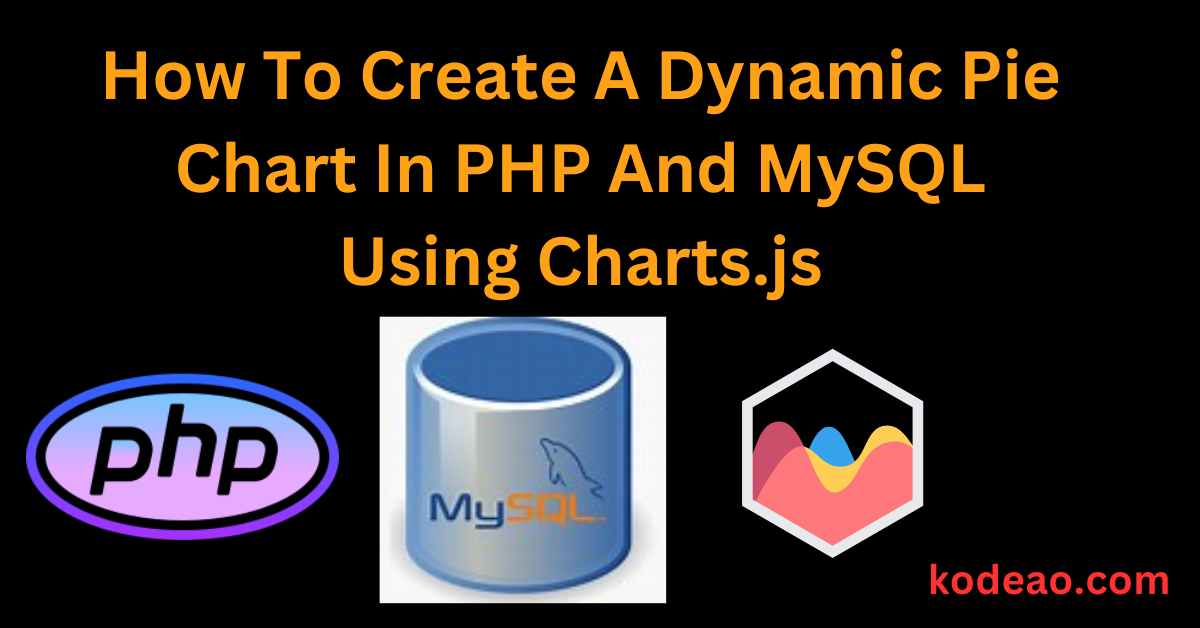Introduction
Dynamic pie charts can greatly enhance the visualization of data, making complex information easier to understand at a glance. Using PHP and MySQL, you can dynamically generate pie charts based on database values, making the charts responsive to any updates in the data. In this guide, we’ll walk you through creating a dynamic pie chart in PHP using MySQL data and the Chart.js library.
Prerequisites For Creating A Dynamic Pie Chart in PHP
Before starting, make sure you have the following set up:
- PHP and MySQL server (e.g., XAMPP, WAMP, or LAMP).
- Basic knowledge of PHP and MySQL.
- Chart.js Library – A popular JavaScript library for creating responsive charts
Step 1: Set Up Your Database
Create a new database and table in MySQL to store the data you want to visualize. In this example, we’ll create a simple table for sales data.
CREATE DATABASE chart_data;
USE chart_data;
CREATE TABLE sales_data (
id INT AUTO_INCREMENT PRIMARY KEY,
category VARCHAR(50),
amount INT
);
INSERT INTO sales_data (category, amount) VALUES
('Electronics', 500),
('Books', 300),
('Furniture', 200),
('Clothing', 100),
('Accessories', 50);Step 2: Connect to MySQL Database in PHP
Create a new PHP file to connect to the MySQL database and retrieve data from the sales_data table.
<?php
$host = 'localhost';
$db = 'chart_data';
$user = 'root';
$password = '';
try {
$conn = new PDO("mysql:host=$host;dbname=$db", $user, $password);
$conn->setAttribute(PDO::ATTR_ERRMODE, PDO::ERRMODE_EXCEPTION);
} catch (PDOException $e) {
echo "Connection failed: " . $e->getMessage();
}
?>This script establishes a connection to the MySQL database using PDO, a PHP extension for secure and efficient database interaction.
Step 3: Fetch Data from the Database
Now, retrieve the data from the sales_data table and format it for the pie chart.
<?php
// Fetch data
$stmt = $conn->prepare("SELECT category, amount FROM sales_data");
$stmt->execute();
$data = $stmt->fetchAll(PDO::FETCH_ASSOC);
// Separate data into labels and values
$labels = [];
$values = [];
foreach ($data as $row) {
$labels[] = $row['category'];
$values[] = $row['amount'];
}
// Convert PHP arrays to JavaScript
$labels_json = json_encode($labels);
$values_json = json_encode($values);
?>This script fetches all rows from the table, then splits the data into labels (categories) and values (amounts) to be used in the pie chart.
Step 4: Display the Chart Using Chart.js
Add HTML and JavaScript to display the pie chart using the Chart.js library.
1. Include Chart.js – Add the following script in your HTML file to include Chart.js:
<script src="https://cdn.jsdelivr.net/npm/chart.js"></script> 2. Create a Canvas Element – Add a <canvas> element where the chart will render.
<div>
<canvas id="myPieChart"></canvas>
</div>3. Generate the Chart – Use JavaScript to generate the pie chart with dynamic data.
<script>
// Get data from PHP
var labels = <?php echo $labels_json; ?>;
var values = <?php echo $values_json; ?>;
// Create pie chart
var ctx = document.getElementById('myPieChart').getContext('2d');
var myPieChart = new Chart(ctx, {
type: 'pie',
data: {
labels: labels,
datasets: [{
data: values,
backgroundColor: ['#ff6384', '#36a2eb', '#cc65fe', '#ffce56', '#4bc0c0']
}]
},
options: {
responsive: true,
plugins: {
legend: {
position: 'top'
}
}
}
});
</script>Here’s what this code does:
labelsandvaluesare JavaScript variables populated with data from the PHP arrays.- The Chart.js
new Chart()function initializes the pie chart with the specified data, type, and color settings.
Step 5: Test Your Chart
Save and run your PHP file in a browser. If everything is set up correctly, you should see a dynamic pie chart displaying the data from your MySQL database.
Step 6: Make the Chart Dynamic (Optional)
To make your chart update in real time, consider using AJAX to fetch data at intervals without reloading the page. Here’s a basic example:
- Create a PHP file (
data.php) to return data as JSON.
<?php
header('Content-Type: application/json');
include 'db_connection.php';
$stmt = $conn->prepare("SELECT category, amount FROM sales_data");
$stmt->execute();
$data = $stmt->fetchAll(PDO::FETCH_ASSOC);
echo json_encode($data);
?>2. Update Chart Data with AJAX in your main file.
setInterval(function() {
fetch('data.php')
.then(response => response.json())
.then(data => {
var labels = data.map(item => item.category);
var values = data.map(item => item.amount);
myPieChart.data.labels = labels;
myPieChart.data.datasets[0].data = values;
myPieChart.update();
});
}, 5000); // Refresh every 5 seconds
The AJAX script above fetches updated data from data.php and updates the pie chart without reloading the page.
Conclusion
Creating a dynamic pie chart in PHP and MySQL is a straightforward way to enhance your web applications with interactive, real-time data visualizations. By following these steps, you can effectively use Chart.js to create dynamic pie chart in php, making your PHP application more engaging and informative.
FAQs
Q: Can I use other chart libraries besides Chart.js?
A: Yes! Libraries like Google Charts and D3.js are also popular for data visualization.
Q: How can I customize the chart colors?
A: Modify the backgroundColor property in the dataset to specify different colors.
Q: What if I have a large dataset?
A: For large datasets, consider server-side aggregation before passing data to the chart to maintain performance.
Final Thoughts
By creating dynamic charts with PHP and MySQL, you can bring a new level of interactivity and insight to your web applications. Keep experimenting with different chart types, and don’t hesitate to explore other visualization libraries to make your data even more impactful. Happy coding!

